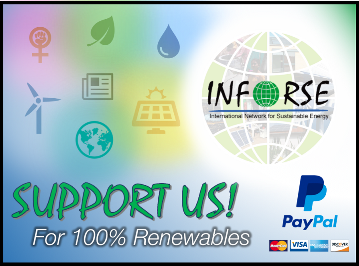|
|
|
|
|
|
|
|
|
|
|
|
|
|
|
|
|
|
|
|
|
| Follow Us: |
| Sustainable Energy for the Poor | |
| By Rene Karottki, SEED South Africa / Advisor from OVE, Denmark | |
| Delivery, integration, and local participation, - major challenges in the new millennium | |
| During the 1980s and in the beginning of the 1990s, most energy and development projects were driven by a specific technology, such as diesel, hydro, wind, solar etc., and were supply-oriented, e.g. with a focus on electrification. This approach was to some extent successful for large-scale projects that provide energy to national grids and operate within the ‘modern’ sector of developing countries. It has however been much less successful in relation to energy for rural development. Numerous projects have left solar, wind, and biogas plants and stoves idle in rural communities without any infrastructure to maintain them and without any ability to take informed decisions at the local level on how to move forward. | |
| Electrification | |
|
In urban areas, decision makers saw electrification as the solution to the energy problems, but experience has shown a different picture. In South Africa, poor, electrified households cover only 20-25% of their energy needs from electricity, and the rest from paraffin, coal, charcoal, wood or similar sources. The electricity bill may be difficult to meet, leading to frequent cut-offs and irregularities. And the indoor pollution from burning wood or fossil fuels continues to cause respiratory diseases and a high mortality among women and children. During the 1990s, many sustainable and renewable energy technologies have reached technical and economical maturity, but the difficulties in reaching the disadvantaged majorities in poor urban and rural areas remain. The issue of delivery is now becoming crucial and is increasingly setting the agenda for governments, NGOs and other actors in the field of sustainable energy. |
|
| Rural / Urban Poor | |
|
On the rural side of this agenda, there are different models. Some are based on direct sale of e.g. individual PV-systems to the end-users, others on co-operative models of ownership and maintenance. More recently, energy service companies (ESCOs) or rural utilities emerged. They are often private companies providing energy services to rural areas and based on direct payment-for-service by the end-user. The energy service may be just supply of electricity (e.g. via solar home systems or PV systems for schools, clinics, water pumping etc.) or may be more comprehensive and include space heating, cooking, process energy for agriculture, rural industries etc. The models are adapted to specific conditions, and different financial models are applied. The introduction is often facilitated by governments and NGOs and backed on a fairly large scale via subsidies from the governments and/or soft loans from the World Bank and other donors. The sustainable energy agenda for the urban poor is less visible. Some activities are being developed around housing, focusing on orientation (passive solar), insulation, efficient and cleaner appliances and renewable energy such as solar water heaters/cookers, but the urban agenda seems generally to be less popular among decision makers, NGOs, and donors. This may however change over the next years due to the increasing global attention to the problems of urbanisation, including the environmental impacts. |
|
| Questions | |
|
This development raises some important questions. - How do energy and development initiatives comply with local needs, and how do they integrate in other sectors? - Are end-users, communities, and local authorities sufficiently informed about alternative solutions to their energy problems and able to make a qualified choice? - Are they properly involved in the design and implementation, and in the subsequent operation? - For rural areas, will individual solutions (such as e.g. solar home systems) create barriers for more efficient collective solutions? - Why is there less attention to alternatives to private energy utilities, such as co-operative and other collective models of investment and ownership? - Will private sector energy companies be able to generate a viable profit from servicing dispersed rural communities? - What will happen if they go bankrupt after two years, or if they do not perform? These are just some of the questions that need to be addressed from the point of view of end-users and local communities. But who is going to raise such questions? And how are they communicated to decision makers in government, international organisations and the private sector? |
|

| |
| Published in Sustainable Energy News |
|
|
Go back to main page of ISSUE #26 (855KB) 18 pages (1999-08-01) |
|
| Contact | |
| |
INFORSE Secretariat Klosterport 4F, 1. floor DK-8000 Aarhus C Denmark Phone: +45 86 22 70 00 Twitter: INFORSE_org Facebook: INFORSE Web: inforse.org E-mail: ove@inforse.org |
